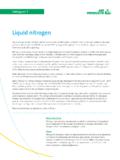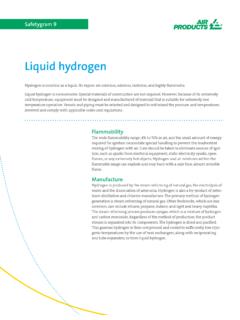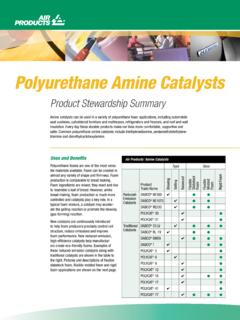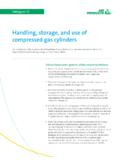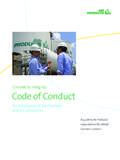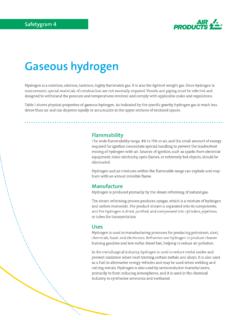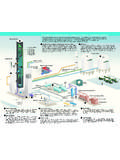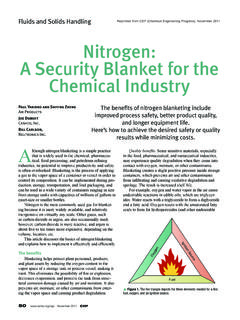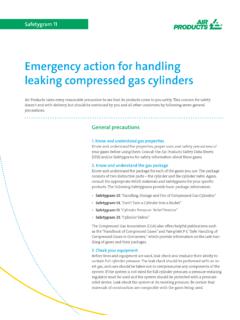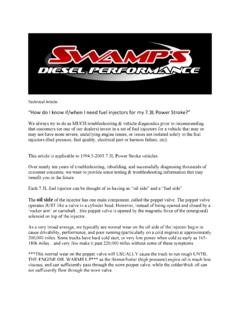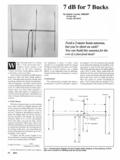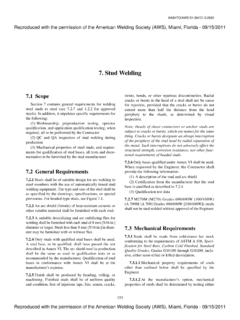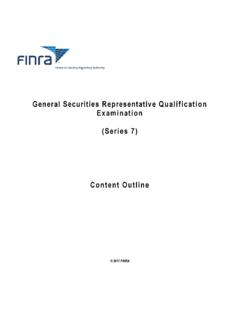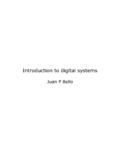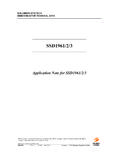Transcription of Liquid nitrogen - Air Products & Chemicals
1 Safetygram 7. Liquid nitrogen Liquid nitrogen is inert, colorless, odorless, noncorrosive, nonflammable, and extremely cold. nitrogen makes up the major portion of the atmosphere ( by volume, by weight). nitrogen is inert and will not support combustion;. however, it is not life supporting. nitrogen is inert except when heated to very high temperatures, where it combines with some of the more active metals, such as lithium and magnesium, to form nitrides. It will also combine with oxygen to form oxides of nitrogen and, when combined with hydrogen in the presence of catalysts, will form ammonia. Since nitrogen is noncorrosive, special materials of construction are not required to prevent corrosion. However, mate- rials of construction must be selected to withstand the low temperature of Liquid nitrogen .
2 Vessels and piping should be designed to American Society of Mechanical Engineers (ASME) specifications or the Department of Transportation (DOT) codes for the pressures and temperatures involved. Although used more commonly in the gaseous state, nitrogen is commonly stored and transported as a Liquid , affording a more cost-effective way of providing product supply. Liquid nitrogen is a cryogenic Liquid . Cryogenic liquids are liquefied gases that have a normal boiling point below 130 F. ( 90 C). Liquid nitrogen has a boiling point of 320 F ( 196 C). The temperature difference between the product and the surrounding environment, even in winter, is substantial. Keeping this surrounding heat from the product requires special equipment to store and handle cryogenic liquids.
3 A typical system consists of the following components: a cryogenic storage tank, one or more vaporizers, and a pressure and temperature control system. The cryogenic tank is constructed like, in principle, a vacuum bottle. It is designed to keep heat away from the Liquid that is contained in the inner vessel. Vaporizers convert the Liquid nitrogen to its gaseous state. A pressure control manifold controls the pressure at which the gas is fed to the process. Processes that use nitrogen as a Liquid do not require the vaporizers and pressure control manifold. Physical and chemical properties are listed in Table 1. Manufacture nitrogen is produced at air separation plants by liquefaction of atmospheric air and separation of the nitrogen by continuous cryogenic distillation.
4 The nitrogen is then recovered as a cryogenic Liquid . Uses nitrogen is the largest volume inorganic chemical sold in the world, supporting a multitude of commercial and technical applications. In its Liquid state, nitrogen is used for food freezing, plastic and rubber deflashing and grinding, cooling, metal treating, biological sample preservation, pulverization, and other temperature-related applications. Table 1: Liquid nitrogen Physical and chemical Properties chemical Formula N2. Molecular Weight Boiling Point @ 1 atm F ( C). Freezing Point @ 1 atm F ( C). Critical Temperature F ( C). Health effects Critical Pressure psia ( atm). Being odorless, colorless, tasteless, Density, Liquid @ BP, 1 atm lb/scf ( Kg/m3). and nonirritating, nitrogen has no Density, Gas @ 68 F (20 C), 1 atm lb/scf ( Kg/m3).
5 Warning properties. Humans possess Specific Gravity, Gas (air=1) @ 68 F (20 C), 1 atm no senses that can detect the pres- Specific Gravity, Liquid (water=1) @ 68 F (20 C), 1 atm ence of nitrogen . Although nitrogen Specific Volume @ 68 F (20 C), 1 atm scf/lb ( m3/kg). is nontoxic and inert, it can act as a Latent Heat of Vaporization 856 Btu/lb ( kJ/kg). simple asphyxiant by displacing the Expansion Ratio, Liquid to Gas, BP to 68 F (20 C) 1 to 694. oxygen in air to levels below that required to support life. Inhalation of nitrogen in excessive amounts can Containers Dewars cause dizziness, nausea, vomiting, loss Liquid nitrogen is stored, shipped and Figure 1 illustrates a typical, vacuum- of consciousness, and death. Death handled in several types of contain- jacketed dewar.
6 A loose fitting dust may result from errors in judgment, ers, depending upon the quantity cap over the outlet of the neck tubes confusion, or loss of consciousness required by the user. The types of con- prevents atmospheric moisture from that prevents self-rescue. At low oxy-tainers in use are the dewar, cryogenic plugging the neck and allows gas pro- gen concentrations, unconsciousness Liquid cylinder, and cryogenic storage duced from vaporized Liquid to escape. and death may occur in seconds and tank. Storage quantities vary from a This type of container is a nonpressur- without warning. few liters to many thousands of gal- ized container. The unit of measure lons. Since heat leak is always present, for the capacity of a dewar is typically Personnel, including rescue workers, vaporization takes place continuously.
7 The liter. Five- to 200-liter dewars are should not enter areas where the Rates of vaporization vary, depending available. product may be removed oxygen concentration is below , on the design of the container and the from small dewars by pouring, while unless provided with a self-contained volume of stored product . larger sizes will require a transfer breathing apparatus or air-line tube. Cryogenic Liquid cylinders that respirator. Containers are designed and manu- are pressurized vessels are sometimes factured according to the applicable incorrectly referred to as dewars. For more information on oxygen- codes and specifications for the tem- deficient atmospheres, consult peratures and pressures involved. Air Products ' Safetygram #17, Figure 1: Typical Dewar Dangers of Oxygen-Deficient Atmospheres.
8 Extensive tissue damage or burns can result from exposure to Liquid nitrogen or cold nitrogen vapors. 2. Cryogenic Liquid cylinders Figure 2a: Typical Cryogenic Liquid Cylinder, side view Figure 2 shows a typical cryogenic Liquid cylinder. Cryogenic Liquid cylin- Liquid Level Gauge ders are insulated, vacuum-jacketed Handling Ring pressure vessels. They come equipped Handling Post with safety relief valves and rupture Annular Space Rupture Disk discs to protect the cylinders from Inner Vessel pressure buildup. These containers Gas Use Vent Tube operate at pressures up to 350 psig Vaporizer (Optional). and have capacities between 80 and Liquid Tube Outer Vessel 450 liters of Liquid . Float Assembly product may be withdrawn as a gas by passing Liquid through an internal Rubber Shock vaporizer or as a Liquid under its own Mounts vapor pressure.
9 For more details on Foot Ring the construction and operation of cryogenic Liquid cylinders, consult Air Products ' Safetygram #27, Cryogenic Liquid Containers. Figure 2b: Typical Cryogenic Liquid Cylinder, top view Rupture Disk Pressure Gauge Pressure Gauge Relief Valve Rupture Disk Vent Valve Gas Disk Vent Valve Liquid Valve Pressure Pressure Liquid Valve Building Building Regulator Valve Economizer Regulator 3. Cryogenic storage tanks Figure 3: A Typical Customer Station with a Cryogenic Storage Tank A typical customer installation (see Figure 3) includes a tank, a vapor- izer, and a pressure control manifold. Tanks may be spherical or cylindrical in shape. They are mounted in fixed locations as stationary vessels or on railroad car or truck chassis for easy transportation.
10 Sizes range from 500. to 420,000 gallons, and all tanks are powder- and vacuum-insulated in the annular space. Tanks are equipped with various circuits to control prod- uct fill, pressure buildup, pressure relief, product withdrawal, and tank vacuum. Tanks are designed to ASME. specifications for the pressures and temperatures involved. Transfer lines NOTE: Liquid cylinders designed A Liquid transfer line is used to safely to dispense gaseous nitrogen have remove Liquid product from dewars valves equipped with standard or cryogenic Liquid cylinders. A typical Compressed Gas Association (CGA). transfer line for dewars is connected outlets. Suitable pressure regulating to a bayonet that provides a means of equipment may be attached. Valves using product vapor pressure buildup provided for the withdrawal of Liquid or an external pressure source to product are also equipped with stan- remove the Liquid .
